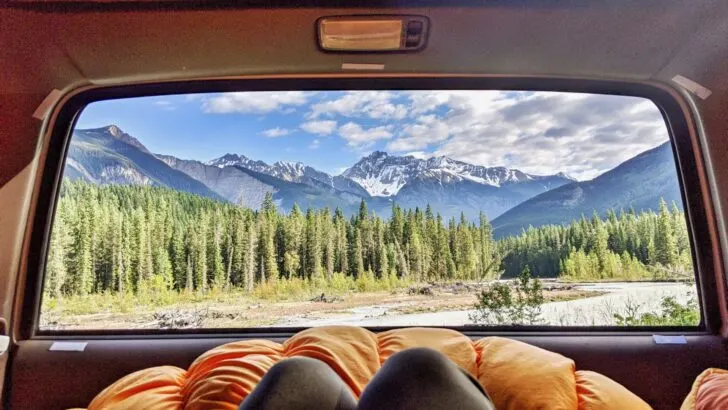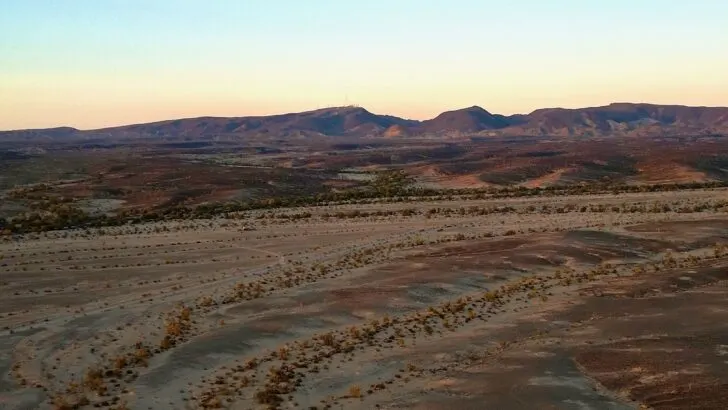Dispersed camping is far and away our favorite way to camp. And that’s saying something, since we have a fair amount of camping experience — we’ve lived and traveled full time in our motorhome for 20 years! But, what is dispersed camping? How much does it cost? And where do you go to experience it?
In this post, we’re offering details about dispersed camping for the benefit of those who haven’t tried it. In our opinion, dispersed camping is a special kind of awesome. So, let’s talk about what it is and how to get there!
What Is Dispersed Camping?
Dispersed camping is camping on public land without hookups AND without a designated campsite.
We use the term “boondocking” a lot on this blog, and you may have seen articles that use the term “wild camping” or “off-grid” camping as well. These terms all mean essentially the same thing – camping without hookups to electricity, a city water source, or a sewer inlet, mostly in areas that aren’t designated campgrounds.
The term “dispersed camping” is the official term used by state, federal, and provincial governments in identifying areas of land where it’s legal to do it (as long as you respect the rules and regulations).
Is Boondocking the Same as Dispersed Camping?
Yes and no. There are nuances that distinguish one term from the other, though they are commonly considered interchangeable.
All dispersed camping is boondocking, but not all boondocking is considered dispersed camping.
Here’s the difference:
Governments designate what they call “dispersed camping” areas – portions of government-owned land where it’s legal to boondock.
Everyone who takes part in dispersed camping is boondocking, meaning they’re not tethered to hookups such as electricity, city water, or sewer.
But you can also “boondock” (or “dry camp”) in a designated campsite with no hookups, in your driveway, or overnight in a parking lot on your way to a camping destination. (See our post entitled “Can You Camp in Walmart Parking Lots?” for details.)
You can also boondock in a friend’s backyard (commonly also referred to as “moochdocking”), at a Harvest Hosts location, or in a designated space in a structured campground in a National Forest or recreation area.
You’re boondocking if you’re stealth camping or using free overnight RV parking anywhere (anytime your RV isn’t hooked up to water or electricity). Even car camping is a form of boondocking.
But if you’re camping (boondocking) on public land that isn’t located in a designated camping area, THEN you’re taking part in dispersed camping.

Dispersed camping is really about WHERE you camp, and terms like “boondock”, “dry camp”, and “wild camp” are related to HOW you camp (without hookups).
What’s So Great About Dispersed Camping?
We love dispersed camping and have been doing it for decades, so it’s hard for us to narrow down its many advantages, but we’ll do our best to keep it brief!
No Cost
OK, let’s get this over with first: it’s free! And anyone who’s been an RVer or camper for any length of time at all understands how quickly campground fees can add up.
People invest their hard-earned money in an RV with an understanding that they’re taking on maintenance, repair, and fuel costs. But it can quickly become clear that campground & RV park fees can also add up, especially for those of us who travel frequently or full-time.
Campgrounds and RV parks are increasingly expensive, so it’s pretty hard to argue with the “free” part of dispersed camping. But for us… this is the least interesting/compelling part. Sure, we’re all for saving a buck here or there, too. It’s just not the PRIMARY reason we enjoy it. There’s a lot more to it, like…
Quiet and Solitude
Dispersed camping is very different from the buzz of a campground or RV park. Don’t get us wrong, we definitely enjoy staying at an RV park or campground with full hookups, especially after a long stint of dispersed camping. Sure, we need to dump our waste tanks and fill up with potable water. But there’s almost a guilty pleasure to taking a nice long shower!
All that said, however, nothing beats the quiet of the desert or the forest. And there’s something special about camping in the wilderness away from the noise, without your awning touching the neighbor’s slide-out!
Can you find us in this dispersed camping picture?

Keep looking! Don’t give up! We’re out there somewhere! (Need a magnifying glass? Try clicking on the image to see it bigger!) Beautiful silence, with the exception of the evening coyote symphony.
Spending Time in Amazing Places
We’d never have experienced many places had we not become fans of dispersed camping. Thanks to dispersed camping, we’ve woken up in some of the most beautiful natural environments.
It may be hard to understand for those who’ve never stepped outside the comfort of a campground. But once you do it, you’ll understand the draw.
What Do I Need for Dispersed Camping?
The only thing you really need for dispersed camping is water, food, a way to store & remove all your trash, and an understanding of the rules that apply to camping on managed lands.
Depending on how you camp, there are a number of other things you may need.
Power
If you want to have access to amenities like the electrical appliances of your RV or your electronic devices, then you’ll need to have a battery system and a way to charge it, such as RV solar panels, a regular generator, or a solar generator for RVs.
Some campers require very little battery power, while we powerhogs others require a more substantial power setup.
To be fair, we live and work in our RV full time, so when we spend a couple of weeks in the desert, we have some pretty significant power needs. That’s why we’ve got 1,300 watts in our ultimate RV solar panel system feeding a 600 Ah Xantrex Freedom e-GEN lithium battery system.
Water
We’re aware that we already mentioned water, but some campers need more water than others. Potable water is important for drinking, washing dishes, and showering.
Depending on how long you intend to camp and how many people and/or pets are camping with you, you’ll need to ensure you have sufficient water.
If you’re going to be out for a couple of weeks and your RV fresh water tank doesn’t hold enough water, you could always look into an RV water bladder.
Bear Canisters
We’ve never needed them, but depending on where you intend to go, you may need a bear canister or two to keep the smell of your food from attracting bears or other critters.
When you’re investigating the areas where you’d like to do your dispersed camping, just be sure to pay attention to notices about bears so you’re aware of the potential for their presence and can properly prepare.
Like bringing a bear canister like this:
- Every ounce matters! The BV500 excels as a high volume, lightweight bear barrel for backpacking. The most spacious choice of bear canister for...
- Clear and easy to use: Easily find your breakfast. Transparent sides and a wide opening make it easy to find. Tool-free, with rounded corners and pack...
A Full Understanding of the Rules
And finally, you’ll need to understand the rules of dispersed camping on federal or provincial lands.
In the United States, BLM land is the most common land for dispersed camping, while in Canada, it’s Crown land.
There are a number of rules that you’ll want to be familiar with as you plan your camping trip. For example, in most BLM locations, you can only camp for a total of 14 days, after which you need to move to another area (often a certain distance away to ensure you’re not just ricocheting from spot to spot every 14 days).
“BLM” is the Bureau of Land Management, so check the BLM website as you’re planning your camping trip to get up-to-date information. This way, you’ll be aware in advance of such things as fire restrictions that may be currently in place limiting fire pits or use of existing fire rings, etc.
It’s also helpful to check the “Know Before You Go” section if you’ve never participated in dispersed camping on public land before.
The same is true if you plan to camp on U.S. Forest Service land. You can check in with the Forest Service office in the region where you’d like to camp, and you can also browse the U.S. Forest Service website for more information.
It’s also incredibly important to practice “Leave No Trace” principles. Free dispersed camping will remain available to us all if we take these principles seriously.
Leave No Trace Principles
“Leave No Trace” is key to caring for the wild areas we visit. The principles have been established by the Leave No Trace organization and developed by the US Forest Service, National Park Service, and Bureau of Land Management.
The 7 Leave No Trace principles are:
- Plan Ahead and Prepare
- Travel and Camp on Durable Surfaces
- Dispose of Waste Properly
- Leave What You Find
- Minimize Campfire Impacts
- Respect Wildlife
- Be Considerate of Other Visitors
If you remember to carry out whatever you bring in, leave nothing, take nothing, and be extraordinarily cautious with fires, you’ll be well on your way to respecting Leave No Trace principles.
Remember that “leave nothing” includes human waste. If you must dig a proper hole to deposit human waste, it should be done a minimum of 100 feet from any water source. The same is true of urine. Toilet paper must be carried out, not buried or left behind, so be prepared to deal appropriately with toilet paper.
How to Find Places to Enjoy Dispersed Camping
In addition to the websites of the Bureau of Land Management (use their interactive map) and the U.S. Forest Service, you can also use a number of other resources to find areas for dispersed camping.
Once you choose an area where you’d like to camp, you can use Google Maps’ satellite view to identify a good camping spot (and the route to get there).
Be sure to check out our post on the 11 best ways to find RV boondocking spots.
Here are a few of the best outside resources for finding more dispersed camping spots:
Campendium
Campendium is a website and an app that allows you to browse camping locations. You’ll find reviews on everything from campsites to cellphone coverage for all the major carriers.
Campendium uses crowdsourced reviews and photos to give you a feel for an area and is part of Roadpass Digital.
Feel free to use our coupon if you’d like to try it!
Upgrade your RVing experience with Roadpass Plus. One annual subscription gets you access to Roadtrippers Plus (a comprehensive trip planner), Campendium (for finding free boondocking spots all...Show More
Upgrade your RVing experience with Roadpass Plus. One annual subscription gets you access to Roadtrippers Plus (a comprehensive trip planner), Campendium (for finding free boondocking spots all over North America), OvernightRVParking.com (for finding free overnight RV parking spots), RV-Safe GPS (for RV-specific turn-by-turn navigation), and access to savings on RV Tires (save up to 45% on major brands).
Save $10 on your subscription when you sign up using coupon code RVGEEKS.
Show LessThe Dyrt
We have an entire post on The Dyrt app, and it’s loaded with great information on all types of camping.
For more resources related to dispersed camping, try The Dyrt Pro using this RVgeeks coupon:
Use the "Go To The Deal" button to access the website, then click the "Redeem Your Gift" button found there to start your FREE 30-DAY TRIAL (a credit card is required, but you can cancel at any...Show More
Use the "Go To The Deal" button to access the website, then click the "Redeem Your Gift" button found there to start your FREE 30-DAY TRIAL (a credit card is required, but you can cancel at any time).
NOTE: the discount code field should fill in automatically. If it doesn't, click "I have a discount code" and enter code RVGEEKS to start your 30-day free trial.
Show LessiOverlander
iOverlander is another crowdsourced resource for finding dispersed camping.
In the US alone, there are 19,882 reviews, more skewed toward smaller and off-road-capable rigs. Click on the area you want to explore, and narrow it down to the specific campgrounds and parking areas.
iOverlander also lists nearby places to get propane, recycling, pet services, mechanics, and fuel.
And yes, you can do some fantastic dispersed camping, even in a Class A RV. We do it all the time! See our complete guide to Class A RV boondocking for many tips and details!
No matter what type of rig you have, however, we strongly recommend that you pay very close attention to limitations on vehicle size and whether or not 4-wheel drive is needed or recommended in certain areas.
Nervous About Disconnecting?
If you’re used to being tethered to full hookups at campgrounds and RV parks (and find the idea of boondocking somewhat intimidating), check out this video in which we’ll show you the easiest way to cut the cord!
Free RVing Tips, Tricks, Reviews, Giveaways & More
Subscribe to our daily newsletter! We’ve been full-time RVers for 20 years (!) and share everything we’ve learned about RVing in our daily blog posts. Join our online community to receive a wealth of great RVing knowledge delivered right to your inbox.
Whether this is your first time on the road or you’re a seasoned full-timer, you’ll love the wide range of RVing topics we cover. Don’t miss a single article or any of our famous RV gear Giveaways — Subscribe today!





Joe Curbelo
Tuesday 31st of January 2023
I have a mode of Boondocking that almost nobody talks about because it doesn't feel like camping. We had an amazing experience going to Gainesville, FL last fall for a Florida Gators football game. We parked in their overflow RV lot (free!) and paid $10/person for a RT bus shuttle to the stadium. Very unique in that you are camping in a parking lot but unlike Wal-Mart, you set up camp. Noise is a factor as everyone is running a generator, including several that have loud portables. Still love the solitude of the wilderness though!
TheRVgeeks
Tuesday 31st of January 2023
Good point... glad you had fun, Joe!
John S.
Tuesday 31st of January 2023
"Dispersed camping is a special kind of awesome."
Beautiful. That says it all.
I consider myself very much a beginner at real dispersed camping only because I don't include Harvest Host stops, overnights at rest stops, friends or shopping centers or even Quartzsite in January as true "Dispersed camping".
But when I see the photos and videos that you (John & Peter) show of the places you've been I certainly know that there are many places I want to visit.
And Yes, I found you in the Quiet and Solitude photo. Can you send me the coordinates for that one?
TheRVgeeks
Tuesday 31st of January 2023
LOL! And we look at photos that people like Tom & Caitlin Morton (Mortons On The Move) post of their travels in their rugged truck camper, and WE get jealous! It's all relative!
That spot was at Indian Pass Road (details available here on Campendium: https://www.campendium.com/indian-pass-road). There are lots of places to stay there, but the GPS coordinates of the exact spot we were in were: 32.961023, -114.834527.
Had the place almost entirely to ourselves for quite a while, then a group of ATVers came in for a weekend and stayed nearby. They were mostly quiet... would head out on a ride in the morning and not come back till almost dark.
Cell service was alternately awesome and aggravating. Seems like the radar or other electromagnetic activities going on at the Yuma Proving grounds (not far east of the spot) seemed to wreak occasional havoc with all carriers. Was worth it, though! ????